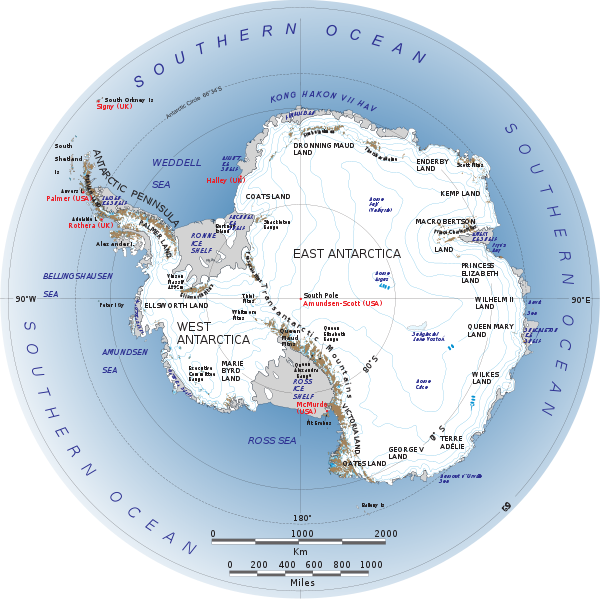 Immer wenn in der Antarktis ein Stück Eis abbricht, wird das Ereignis in den Medien als Zeichen eines gefährlichen, unnatürlichen Klimawandels bejubelt. Dass schon immer Eis von den antarktischen Inlandsgletscher abkalbte, scheinen die Kommentatoren zu verdrängen. Auch die Unterscheidung zwischen der Antarktischen Halbinsel (im Prinzip lediglich einer Verlängerung Südamerikas), der West-Antarktis und der Ost-Antarktis scheint vielen Probleme zu bereiten. So nimmt der ostantarktische Eispanzer derzeit sogar zu. Und das antarktische Meereis als Gesamtheit betrachtet, ist dieses Jahr auf ein rekordverdächtiges Niveau angewachsen (siehe unser Blogartikel „“Noch nie” besaß das antarktische Meereis eine so große Ausdehnung am 267. Tag des Jahres wie 2012„). Schmelz-Berichte über die antarktische Halbinsel sind daher keineswegs repräsentativ für das antarktische Klimageschehen. Hierauf wies jetzt auch eine Autorengruppe um Robert Mulvaney vom British Antarctic Survey in einer im September 2012 in Nature erschienenen neuen Studie hin. In dieser Arbeit können die Autoren zudem zeigen, dass in der Zeit von 9200 bis 2500 Jahren vor heute die Temperaturen auf der antarktischen Halbinsel in etwa auf dem heutigen Niveau lagen. Die Erwärmung im nordöstlichen Teil der antarktischen Halbinsel begann bereits vor 600 Jahren (also lange vor der industriellen Revolution und dem vermehrten CO2-Ausstoß). Die beobachteten Temperatursteigerungsraten des letzten Jahrhunderts bezeichnen die Autoren zwar als „ungewöhnlich“; sie weisen jedoch auch darauf hin, dass es ähnliche Erwärmungsraten bereits in der Vergangenheit im Rahmen der natürlichen Temperaturvariabilität gegeben hat.
Immer wenn in der Antarktis ein Stück Eis abbricht, wird das Ereignis in den Medien als Zeichen eines gefährlichen, unnatürlichen Klimawandels bejubelt. Dass schon immer Eis von den antarktischen Inlandsgletscher abkalbte, scheinen die Kommentatoren zu verdrängen. Auch die Unterscheidung zwischen der Antarktischen Halbinsel (im Prinzip lediglich einer Verlängerung Südamerikas), der West-Antarktis und der Ost-Antarktis scheint vielen Probleme zu bereiten. So nimmt der ostantarktische Eispanzer derzeit sogar zu. Und das antarktische Meereis als Gesamtheit betrachtet, ist dieses Jahr auf ein rekordverdächtiges Niveau angewachsen (siehe unser Blogartikel „“Noch nie” besaß das antarktische Meereis eine so große Ausdehnung am 267. Tag des Jahres wie 2012„). Schmelz-Berichte über die antarktische Halbinsel sind daher keineswegs repräsentativ für das antarktische Klimageschehen. Hierauf wies jetzt auch eine Autorengruppe um Robert Mulvaney vom British Antarctic Survey in einer im September 2012 in Nature erschienenen neuen Studie hin. In dieser Arbeit können die Autoren zudem zeigen, dass in der Zeit von 9200 bis 2500 Jahren vor heute die Temperaturen auf der antarktischen Halbinsel in etwa auf dem heutigen Niveau lagen. Die Erwärmung im nordöstlichen Teil der antarktischen Halbinsel begann bereits vor 600 Jahren (also lange vor der industriellen Revolution und dem vermehrten CO2-Ausstoß). Die beobachteten Temperatursteigerungsraten des letzten Jahrhunderts bezeichnen die Autoren zwar als „ungewöhnlich“; sie weisen jedoch auch darauf hin, dass es ähnliche Erwärmungsraten bereits in der Vergangenheit im Rahmen der natürlichen Temperaturvariabilität gegeben hat.
Hier die Kurzfassung des neuen Nature papers:
Rapid warming over the past 50 years on the Antarctic Peninsula is associated with the collapse of a number of ice shelves and accelerating glacier mass loss. In contrast, warming has been comparatively modest over West Antarctica and significant changes have not been observed over most of East Antarctica, suggesting that the ice-core palaeoclimate records available from these areas may not be representative of the climate history of the Antarctic Peninsula. Here we show that the Antarctic Peninsula experienced an early-Holocene warm period followed by stable temperatures, from about 9,200 to 2,500 years ago, that were similar to modern-day levels. Our temperature estimates are based on an ice-core record of deuterium variations from James Ross Island, off the northeastern tip of the Antarctic Peninsula. We find that the late-Holocene development of ice shelves near James Ross Island was coincident with pronounced cooling from 2,500 to 600 years ago. This cooling was part of a millennial-scale climate excursion with opposing anomalies on the eastern and western sides of the Antarctic Peninsula. Although warming of the northeastern Antarctic Peninsula began around 600 years ago, the high rate of warming over the past century is unusual (but not unprecedented) in the context of natural climate variability over the past two millennia. The connection shown here between past temperature and ice-shelf stability suggests that warming for several centuries rendered ice shelves on the northeastern Antarctic Peninsula vulnerable to collapse. Continued warming to temperatures that now exceed the stable conditions of most of the Holocene epoch is likely to cause ice-shelf instability to encroach farther southward along the Antarctic Peninsula.
Abbildung 1: Antarktis. Quelle: NASA.
Foto oben rechts: User:Stan_Shebs / Lizenz: GNU Free Documentation License, Version 1.2 or any later
